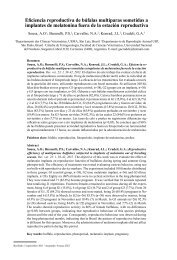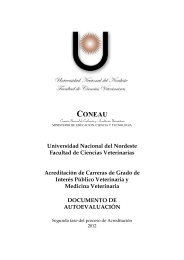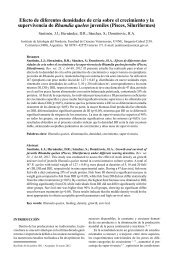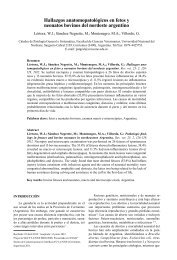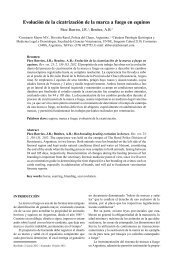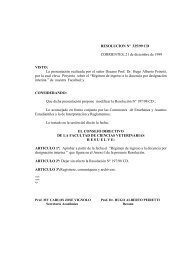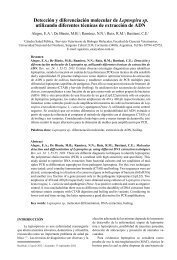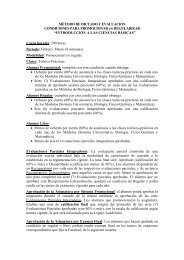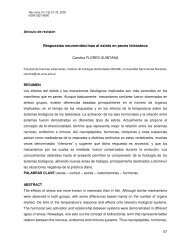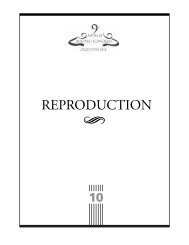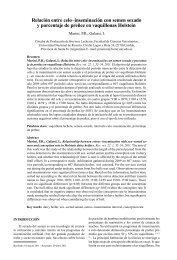MILK PRODUCTION
MILK PRODUCTION
MILK PRODUCTION
Create successful ePaper yourself
Turn your PDF publications into a flip-book with our unique Google optimized e-Paper software.
562<br />
<strong>MILK</strong> <strong>PRODUCTION</strong><br />
Indices of atherogenicity and thrombogenicity<br />
in milk fat from Buffaloes raised under<br />
different feeding systems<br />
Fernandes, S.A. de A. 1 ; Mattos, W. R. S. 2 ; Matarazzo, S. M 3 , Gama, M. A. S. 4 ; Malhado, C. H. M. 1 , Etchegaray, M. A. L. 5;<br />
Lima, C. G. de 2 .<br />
1 - Universidade Estadual do Sudoeste da Bahia (UESB), Praça Primavera, 40. DTRA/UESB. Itapetinga, Brasil. CEP 45.700-000; 2<br />
– Universidade de São Paulo (USP); 3 - Universidade Estadual de Santa Cruz (UESC); 4 - EMBRAPA Gado de Leite/Juiz de Fora. Email:<br />
fernandes_pe@hotmail.com<br />
Abstract<br />
This study aimed to evaluate the effect of different feeding systems on milk fat quality of Murrah buffaloes. Forty Murrah<br />
buffaloes from 5 different Brazilian farms (n=8 animals/farm) were used. Milk samples were collected monthly throughout a<br />
single lactation, and fatty acid profile was determined by gas chromatography. Milk fatty acid profile was used to calculate the<br />
nutritional quality of milk fat according to the following indices: atherogenicity index (AI); thrombogenicity index (TI); omega<br />
6/omega 3 (n6/n3) ratio and desirable fatty acids (DFA). Statistical analyses were performed using PROC Univariete from 7 .<br />
The smallest AI (1.49±0.43) was observed in milk fat from Buffaloes raised in the Farm 3. No differences among farms were<br />
observed for TI and n6/n3 ratio. However, DFA differed among farms, with milk fat of Buffaloes from Farm 3 showing the highest<br />
values (47.17%). Our results showed that nutritional quality of milk fat from Murrah Buffaloes is influenced by different<br />
feeding systems.<br />
INTRODUCTION<br />
Key words: milk fatty acids, atherosclerosis, human health, Buffaloes, nutrition<br />
Due to health concerns, much attention has been focused on milk fat composition. The index of atherogenicity (AI) basically<br />
describes the ratio between pro and anti-atherogenic fatty acids 1 . In milk and dairy products, the value found is around 2<br />
however AI=1,5 is considered low and 2,5 is high 2 . The index of thrombogenicity (IT) considers the major saturated fatty acids<br />
as pro-thrombogenic, while the unsaturated ones are considered anti-thrombogenic 1 . Another index used in nutritional assessment<br />
of fats and oils is the n6/n3 ratio. According to 3 this ratio must be £ 4.0. The objective of this work was to evaluate the<br />
AI, TI, n6/n3 ratio and desirable fatty acids (DFA) in milk fat from Buffaloes raised under different feeding systems.<br />
MATERIAL AND METHODS<br />
This trial was carried out on five commercial farms located at Sarapui (23º38’28” S and 47º49’38” W) and Pilar do Sul<br />
(23º48’44” S and 47º42’29” W) cities, state of São Paulo, Brazil. In each farm, milk samples from eight buffaloes were<br />
collected from April to November 2002. Milk samples were stored at -20º until analyzed for fatty acid composition. The nutritional<br />
management adopted in each farm was as follow: Farm 1- buffaloes were maintained in feedlot and fed corn silage and wet<br />
brewers grain as the main sources of forage and concentrate, respectively; Farm 2 - buffaloes were maintained in feedlot and fed<br />
Proceedings 9 th World Buffalo Congress



